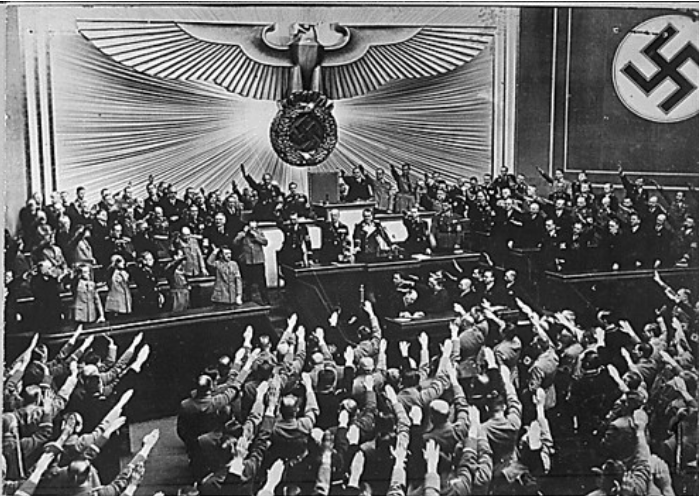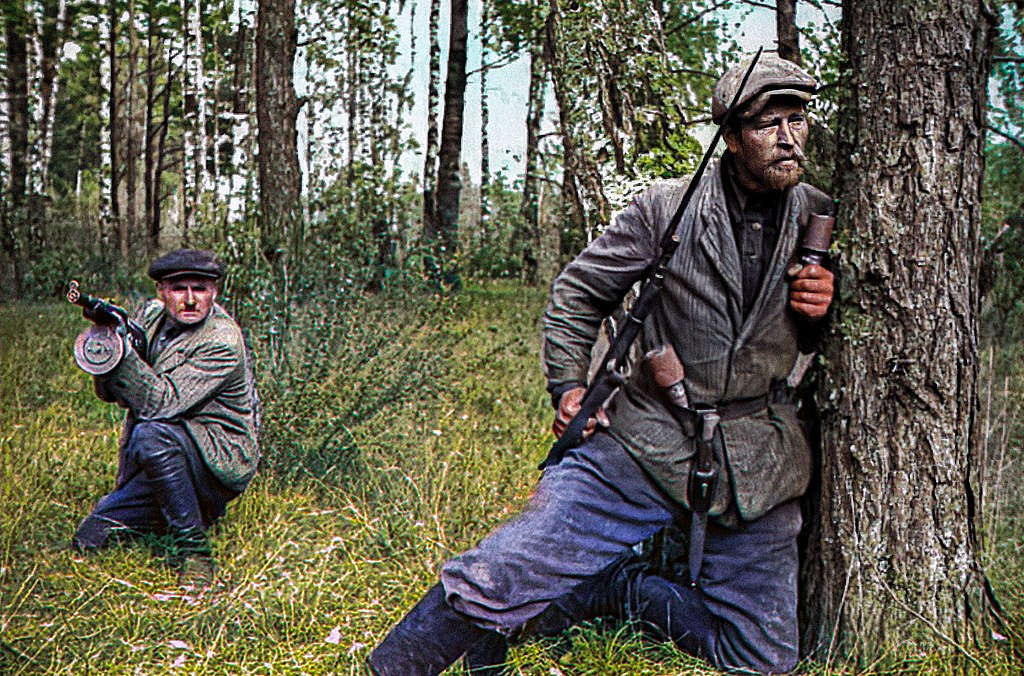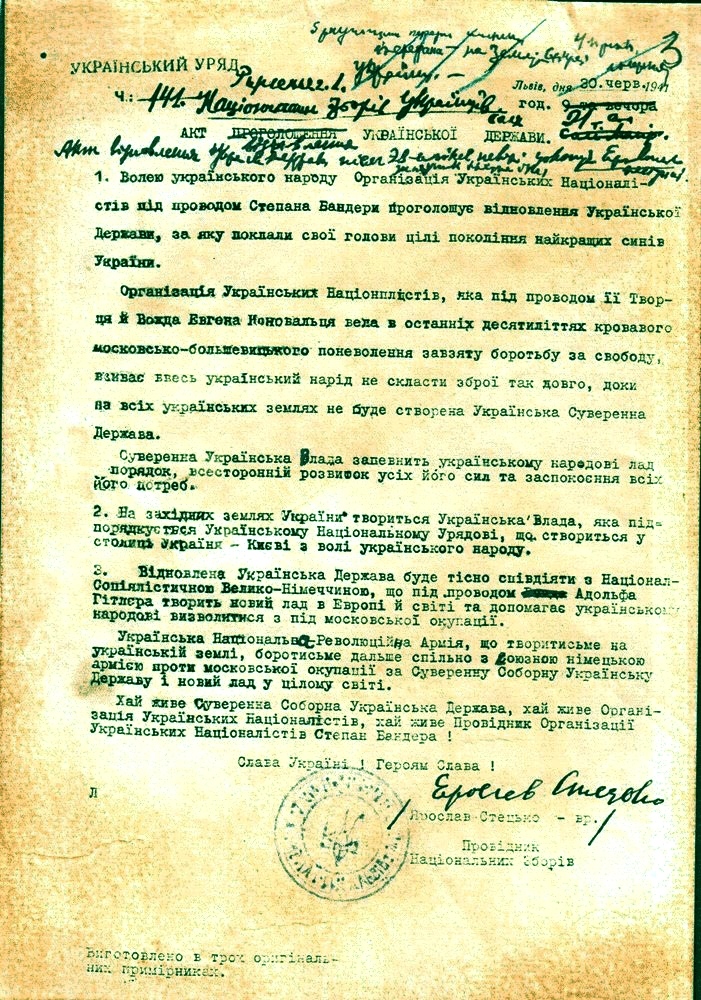Previous Subchapter → 1.3 History - Ukraine in Wartime
A decade later, in the late 1930s, Germany had recovered from the humiliation of defeat and came under the leadership of Fascist dictator Adolf Hitler, who formed alliances and rearmed his country. Germany’s resurgence caused Europe to split once again into two factions, one led by France and the UK, the other led by Germany, the Allies and Axis.

Hitler made his first military moves in 1938 when he began invading former Austro-Hungarian territories: First he annexed Austria itself and then he claimed Czechoslovakia, which you might remember as one of the countries that had taken a piece of Ukraine in the aftermath of the First World War; The Ukrainians in the Czechoslovak region of Carpathian Ruthenia tried to take advantage of this and declared their own independent state called the Republic of Carpatho-Ukraine.
But the Germans ignored them and almost immediately after, with the blessing of Germany, they were invaded by Hungary, placing the Ruthenian Ukrainians back under foreign rule.
After it became clear that the peace settlements of the 1920s weren’t going to hold, the Soviets worked to ensure their own security. After failing to reach a deal with the Allies the Soviets signed an agreement with the Germans and agreed to divide Eastern Europe with them, together they invaded Poland in 1939, with most of Galicia being absorbed into Soviet Ukraine and the rest of Poland being divided between Germany, its partners, and other Soviet Republics.
The Allies reacted strongly to this and demanded that the Germans, but not the Soviets, withdraw from Poland under the threat of war, when Germany refused the Allied nations followed through on their threat, beginning the Second World War. As the war began, the Soviets also took over the Ukrainian sections of Bukovina, the only Ukrainian region left to recover was Ruthenia.
The cooperation between the Soviets and the Germans was short lived, as Hitler was extremely Anti Communist and didn’t want to just take the remains of Austria-Hungary’s dead empire, he wanted the leftovers of the Russian Empire too as “living space”; Germany invaded the USSR in 1941 with Ukraine being one of the first Soviet Republics to be invaded, the Germans occupied Ukrainian territory and split it between two entities, the District of Galicia and Reichskommissariat Ukraine, neither of which were recognised as independent, many Ukrainians fled to join the Soviet Red Army or local partisan groups.
 Soviet partisans in Belarus - 1943
Soviet partisans in Belarus - 1943
Under German occupation, a group known as the OUN or “Organisation of Ukrainian Nationalists”, which had been operating underground in areas like Galicia before the invasions of Poland and the USSR, began to take over large parts of Ukraine.
The OUN was split between two factions, the OUN-M led by a man called Andriy Melnyk, and the OUN-B led by a man called Stepan Bandera, both factions raced to entrench their control over Ukrainian territory and gain support, from both the local population and the German forces.
8 days after the Nazi occupation began, the OUN-B issued a declaration of Ukrainian independence called the “Act of restoration of the Ukrainian state”, this declaration proclaimed that a government was being formed in West Ukraine, and that it would be subordinate to a central Ukrainian government in the capital of Kyiv, it also declared that the new Ukrainian state would “work closely with the National-Socialist Greater Germany, under the leadership of its leader Adolf Hitler which is forming a new order in Europe and the world and is helping the Ukrainian People to free itself from Moscovite occupation”.

Bandera and his front hoped that by declaring their loyalty to Germany the Nazis would allow them to form their independent Ukrainian state, instead the Nazis arrested the OUN’s leadership and threw them into concentration camps, with both OUN factions purged.
The remnants of the groups formed 2 different armies, the OUN-B led Ukrainian Insurgent Army and OUN-M led Ukrainian People’s Revolutionary Army, the Nazis also formed their own forces: A Ukrainian volunteer SS group, the Galicia Division, and other proxies such as the Ukrainian Auxiliary Police.
By 1944 the tide of the war had firmly turned in the favour of the Allies and the Soviets were steadily advancing through German occupied Europe, the Nazis released Bandera and other OUN leaders from prison in the hopes that the two OUN factions could unite and attack Soviet troops, damaging their advance.
They reorganised the Galicia Division into the so-called Ukrainian National Army, under the leadership of a German sponsored “Ukrainian National Committee” linked to both OUN factions, which the Axis finally recognised as representatives of an independent Ukraine.
[Editor’s Note: Reportedly some other collaborator units also participated in the UNA alongside the Galicia Division, one unit the Encyclopedia of Ukraine mentions is an unnamed Anti-Tank Brigade commanded by a “Col P. Diachenko”, Wikipedia names him as Petro Dyachenko and his unit as the “Free Ukraine” Brigade.]
But the German efforts didn’t bear fruit, by late 1944 Reichskommissariat Ukraine had already crumbled, with the remaining collaborators fleeing, fighting for the Nazis elsewhere in Europe or carrying out a small insurgency behind Soviet lines. 2 months after the recognition of the German backed Committee the Nazis unconditionally surrendered to the Allies, including the Soviet Union, the war was finally over but several million Ukrainians had died in the fighting, while Ukraine had still failed to achieve independence the Ukrainians kept the territory that had been annexed by the USSR after the invasion of Poland.
The Soviets had also taken over Carpathian Ruthenia in the last stages of the war, and annexed its Ukrainian portions into the USSR, finally uniting the Ukrainian people under one republic, even if it wasn’t an independent one. Soviet Ukraine was restored and the OUN returned to the underground.
As the Cold War set in and the relations between the USSR and USA turned from alliance to rivalry, the CIA courted the OUN, seeking to use OUN-linked expats in Germany and the underground inside Ukraine itself for intelligence gathering and psychological warfare against the Soviets and their Communist allies in Poland, Czechoslovakia and Romania, to this end the OUN attempted to whitewash their past collaboration attempts with the Nazis, and emphasise their later opposition to the Nazis that took place after these efforts failed, they hoped to earn support in the West by appearing to be both Anti-Nazi and Anti-Soviet.
Bandera was one of these expats, and remained in Germany to lead the OUN with the aid of US intelligence services, who helped him avoid discovery by the Soviets, ultimately these efforts failed, as Bandera was later assassinated and the OUN insurgency was wiped out by the Soviet security forces, with remaining sympathisers either fleeing to join the expat community or hiding their views well for the rest of the Soviet era.
[Editor’s Note: The OUN’s involvement in the Ukrainian National Committee is also a highly contested topic, some have claimed that Bandera and the OUN refused to collaborate with the Nazis after their release from the camps, and sources indicate that Bandera told both the CIA and OUN members that he hadn’t participated in the committee. (See: The Ukrainian Central Committee, 1940-1945: a case of collaboration in Nazi-occupied Poland, Page 533)
But Pavlo Shandruk, the head of the Committee, clearly mentions Bandera as offering his “full support to the end” and having “good will and respect” towards the committee in his book “Arms of Valor”.
So it seems that Bandera lied to the CIA and even his own people about his collaboration with the Nazis near the end of the war, most likely to present the image that the OUN only briefly worked with the Nazis and then quickly broke relations for good after its leadership was arrested. This is an impression that many apologists for the OUN continue with to this day, but Shandruk’s account shows that Bandera was still willing to collaborate with the Nazis even at the very end of the war, as long as his condition: Recognising Ukrainian nationhood, was met.
Also, in addition to the CIA aiding the OUN the British government also helped veterans of the SS Galicia Division resettle in the UK and Canada, where they joined the Ukrainian expat community.
- For more info on this topic you can watch the video “Ukrainian SS In Britain - Postwar SS-Galizien Division Refugees” by Mark Felton https://www.youtube.com/watch?v=UB_Gs-0dhOo]